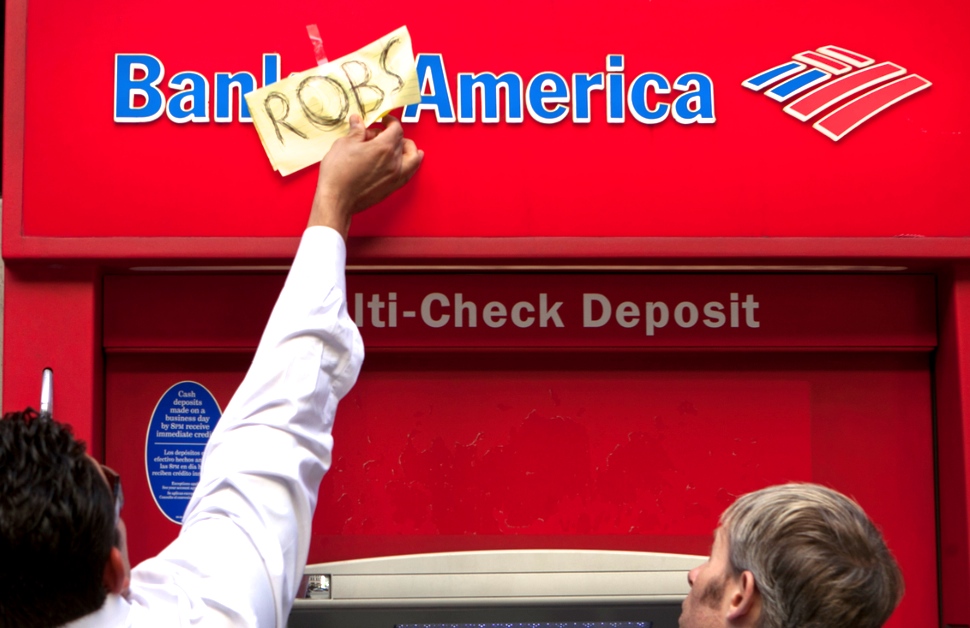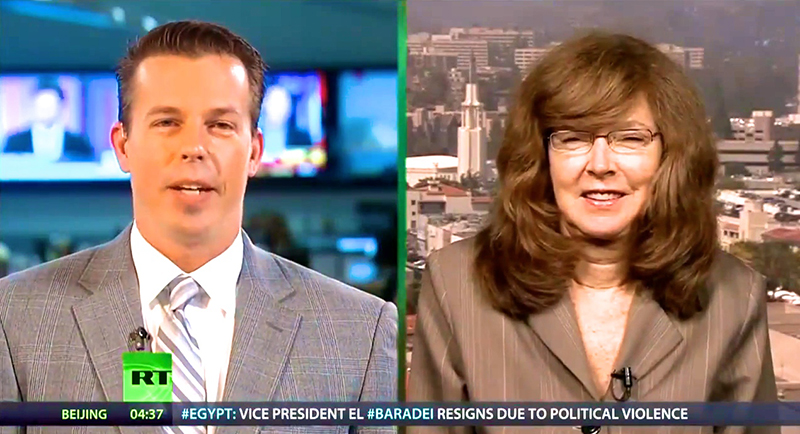
Governor Jerry Brown and his staff are exchanging high-fives over balancing California’s budget, but the people on whose backs it was balanced are not rejoicing. The state’s high-wire act has been called “the ultimate in austerity budgets.”
Welfare payments, health care for the poor, and benefits for the elderly and disabled have been slashed. State workers have been downsized. School districts in need of cash have been reduced to borrowing through “capital appreciation bonds” bearing 300% interest.
In one notorious case, the Santa Ana school district actually borrowed at 1,000% interest. And the governor acknowledges that California still faces a “wall of debt” amounting to $28 billion. Some analysts put it much higher than that.
At the end of the 20th century, California was ranked the sixth largest economy in the world. By 2012, it had slipped to number twelve. It is coming back up, in part because European countries are falling further into recession; but California’s poverty rate remains the highest in the country. More than eight million Californians struggle to meet their daily needs, and one in four children lives in poverty. Income inequality is higher in the nation’s most populous state than in almost any other.
California cannot solve its budget problems by slashing services that have already been cut to the bone or raising sales taxes that hurt the poor far more than the rich. We are fighting over a pie that remains too small. The pie itself needs to be expanded – and it can be.
How? By reclaiming that portion that is now siphoned off in interest and bank fees. When tallied up at every stage of production, interest has been calculated to claim one-third of everything we buy.
How can that money be recaptured? By owning the bank.
The approach was pioneered in North Dakota, the only state to escape the 2008 banking crisis. North Dakota has the lowest unemployment rate in the country, the lowest foreclosure rate, the lowest default rate on credit card debt, and no state debt at all. It is also the only state to own its own bank.
In the fall of 2011, a bill for a feasibility study for a state-owned bank passed both houses of the California legislature. The Public Banking Institute, which I founded and chair, was instrumental in helping to get the bill as far as it got. But it died when Jerry Brown vetoed it. His rationale was that we already have a banking committee, and that the matter could be explored in-house. Needless to say, however, we have heard no more about it since.
I am therefore running for California State Treasurer on a state bank platform, along with Laura Wells, who is running for Controller. We are throwing our bonnets in the ring for the opportunity to show the governor or his successor that a state-owned bank can be our ticket to returning California to the abundance it once enjoyed.
I was a recipient of that abundance myself. I got my undergraduate degree at UC Berkeley in the 1960s, when tuition was free; and my law degree at UCLA Law School in the 1970s, when tuition was $700 a year. Today it is $13,000 and $45,000 annually, respectively, for in-state students.
In the 1960s, the governor of California was Jerry Brown’s father Pat Brown, a New Deal visionary who believed that investment in education, infrastructure and local business was an investment in the future. Our goal is to revive that optimistic vision in 2014.
We are running on the endorsement of the Green Party – along with Luis Rodriguez for governor and David Curtis for secretary of state – because Green Party candidates take no corporate money. Candidates who take corporate money – and that means nearly all conventional candidates – are beholden to large corporate interests and cannot properly represent the interests of the disenfranchised 99%.
The North Dakota Model: Banking that Supports Rather Than Exploits the Local Economy
California’s revenues are currently parked in those very largest of corporations, Wall Street banks. These out-of-state banks use our giant asset pool for their own speculative purposes, and the funds are at risk of confiscation in the event of a “bail-in.”
In North Dakota, by contrast, all of the state’s revenues are deposited by law in the state-owned Bank of North Dakota (BND). The BND is set up as a DBA of the state (“North Dakota doing business as the Bank of North Dakota”), which means all of the state’s capital is technically the bank’s capital. The bank uses its copious capital and deposit pool to generate credit for local purposes.
The BND is a major money-maker for the state, returning a sizable dividend annually to the treasury. Every year since the 2008 banking crisis, it has reported a return on investment of between 17 percent and 26 percent. The BND also provides what is essentially interest-free credit for state projects, since the state owns the bank and gets the interest back. The BND partners with local banks rather than competing with them, strengthening their capital and deposit bases and allowing them to keep loans on their books rather than having to sell them off to investors. This practice allowed North Dakota to avoid the subprime crisis that destroyed the housing market in other states.
Consider the awesome potential for California, with its massive capital and deposit bases. California has over $200 billion stashed in a variety of funds identified in its 2012 Comprehensive Annual Financial Report, including $58 billion managed by the Treasurer in a Pooled Money Investment Account currently earning a meager 0.264% annually. It also has over $400 billion in its pension funds (CalPERS and CalSTRS).
California’s population of 37 million is more than 50 times that of North Dakota. In 2010, the BND had about $4,500 in deposits and $4,200 in loans per capita. Multiplying 37 million by $4,200, a State Bank of California could, in theory, generate $155.4 billion in credit for the state; and this credit would effectively be interest-free free, since the state would own the bank.
What could California do with $155 billion in interest-free credit? One possibility would be to refinance its ominous “wall of debt” at 0%. A debt that is interest-free can be rolled over indefinitely without cost to the taxpayers.
Another possibility would be to fund public projects interest-free. Eliminating interest has been shown to reduce the cost of public projectsby 35% or more.
Take, for example, the San Francisco Bay Bridge earthquake retrofitting boondoggle, which was originally slated to cost about $6 billion. Interest and bank fees wound up adding another $6 billion to the overall cost to taxpayers. Funding through its own bank could have saved the state $6 billion or 50% on this project.
Then there is the state’s bullet train fiasco, which has been beset with delays, cost overruns, and funding issues. As with the Bay Bridge, costs are projected to double as a result of compounding interest on long-term bonds, imposing huge hidden costs on the next generation of taxpayers. By funding the bullet train through a state-owned bank, its costs, too, could be reduced by 50%.

The Challenge of a “Jungle Primary”
As voters become increasingly disillusioned with big-corporate-money candidates, the third party option is gaining traction. According to a recent Gallup poll, in 2013 42% of Americans identified themselves as political independents, significantly outpacing Democrats at 31% and Republicans at 25%.
The growing threat posed by independent and third-party candidates may explain why it is getting harder and harder to run as one. In California we now have Proposition 14, the Top Two primary, sometimes called the “Louisiana primary” or “jungle primary.” It might better be named the Incumbents’ Benevolent Protection Act.
Proposition 14 requires statewide and congressional California candidates, regardless of party preference, to participate in a nonpartisan blanket primary, with only the top two candidates advancing to the general election. Incumbents and heavily-funded candidates have historically reaped the benefits of this arrangement. Third party candidates are liable to get knocked out in the first round in June, eliminating them from the November elections.
But the new system does have the advantage that anyone can vote for any candidate in the June primary; so if we can mobilize voters, we have a shot.
There is, however, another new hurdle imposed by Proposition 14. In place of the 150 signatures-in-lieu-of-filing-fee needed earlier, we now need 10,000 signatures – either that or $2,800. But we’re hoping to turn that requirement, too, to advantage, by using it to build the people power and energy necessary to take the June 3, 2014 primary.
There is another way to balance a state budget, one that leads to prosperity rather than austerity. California can stimulate its economy and the job market, restore low-cost higher education, build 21st-century infrastructure, preserve the environment, and relieve the state’s debt burden, by establishing a bank that is owned by the people and returns its profits to the people.
Ellen Brown is an attorney, president of the Public Banking Institute, and author of twelve books including the bestselling Web of Debt. In The Public Bank Solution, her latest book, she explores successful public banking models historically and globally. She is currently running for California State Treasurer on the Green Party ticket.
3 WAYS TO SHOW YOUR SUPPORT
- Log in to post comments
















